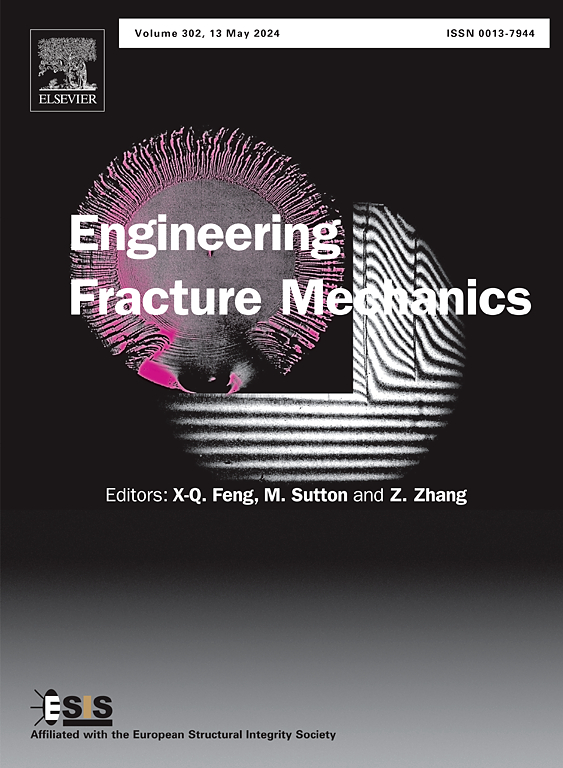Numerical and experimental investigation on rock breaking mechanism and performance of high-pressure energy-gathering water jet
IF 4.7
2区 工程技术
Q1 MECHANICS
引用次数: 0
Abstract
Addressing the issues of short target distance and small nozzle diameter in conventional jet rock breaking, which result in low rock breaking energy and difficulty in achieving efficient rock fragmentation, a high-pressure energy-gathering water jet (HEWJ) device is proposed. Firstly, the relationships between the radial, tangential and shear dynamic stresses of the rock and parameters such as “water hammer pressure” and the distance from the impact point of HEWJ were analyzed. By employing SPH-FEM algorithm, a “ball shaped” HEWJ rock breaking consistent with the theoretical model is established, revealing the stress variation patterns and crack propagation within the rock under the impact of HEWJ with different jet velocity, jet diameter, and surrounding rock stress. Finally, experimental studies were conducted to explore the time-effective characteristics, impact target distances and frequencies on the rock breaking performance. The results indicate that the HEWJ exhibits periodic changes. A single cycle mainly includes the energy storage stage and the impact stage, and the impact stage is very short, only 0.23 s. As the impact time lengthens, the rock breaking volume, the diameter and the depth of the crushing pit increase exponentially and finally tend to be stable. Regarding the impact target distance, the rock breaking volume and the diameter of the crushing pit initially increase but then decline, whereas the depth demonstrates a steadily decreasing tendency. When the flow rate of the hydraulic pump increases from 80 L/min to 140 L/min, the jet impact frequency increases from 0.1914 Hz to 0.3189 Hz and shows a linear growth. Moreover, the rock breaking volume, the diameter and the depth of the crushing pit all show an increasing trend with the growth of the impact frequency. The optimal impact frequency of the HEWJ on the rock is 0.3189 Hz, which indicates that the flow rate of the hydraulic pump is 140 L/min at this time.
高压集能水射流破岩机理及性能的数值与实验研究
针对常规射流破岩靶距短、喷嘴直径小、破岩能量低、难以实现高效破岩的问题,提出了一种高压集能水射流(HEWJ)装置。首先,分析了岩石径向动应力、切向动应力和剪切动应力与“水锤压力”、距冲击点距离等参数的关系;采用SPH-FEM算法,建立了与理论模型相吻合的“球形”HEWJ岩石破碎模型,揭示了不同射流速度、射流直径和围岩应力下的HEWJ冲击下岩石内部应力变化规律和裂纹扩展。最后,进行了试验研究,探讨了冲击目标距离和频率对破岩性能的时效特性。研究结果表明,HEWJ具有周期性变化。单周期主要包括蓄能阶段和冲击阶段,冲击阶段很短,只有0.23 s。随着冲击时间的延长,破碎体积、破碎坑直径、破碎坑深度呈指数增长,最终趋于稳定。在冲击靶距上,破岩体积和破碎坑直径呈先增大后减小的趋势,而深度呈稳定减小的趋势。当液压泵流量从80 L/min增加到140 L/min时,射流冲击频率从0.1914 Hz增加到0.3189 Hz,并呈线性增长。随着冲击频率的增加,破碎体积、破碎坑直径、破碎坑深度均呈增大趋势。HEWJ对岩石的最佳冲击频率为0.3189 Hz,表明此时液压泵的流量为140 L/min。
本文章由计算机程序翻译,如有差异,请以英文原文为准。
求助全文
约1分钟内获得全文
求助全文
来源期刊
CiteScore
8.70
自引率
13.00%
发文量
606
审稿时长
74 days
期刊介绍:
EFM covers a broad range of topics in fracture mechanics to be of interest and use to both researchers and practitioners. Contributions are welcome which address the fracture behavior of conventional engineering material systems as well as newly emerging material systems. Contributions on developments in the areas of mechanics and materials science strongly related to fracture mechanics are also welcome. Papers on fatigue are welcome if they treat the fatigue process using the methods of fracture mechanics.

 求助内容:
求助内容: 应助结果提醒方式:
应助结果提醒方式:


